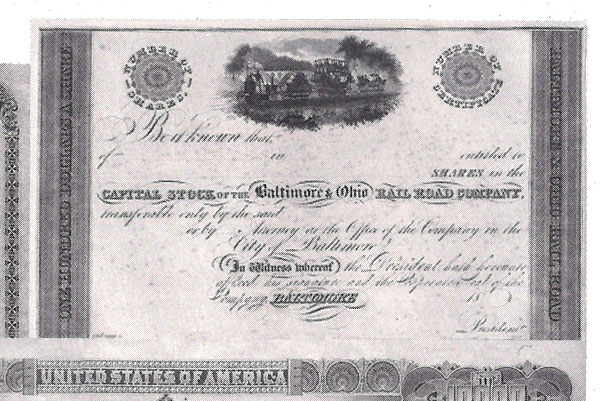G.A. is a long-time correspondent and contributor and asked another great question on August 15. I spent an overly long time on trying to answer his question, so decided to share it here.
Hi Terry - I picked up an 1846 B&O stock certificate recently (BAL-662a-S-25) and it's been bugging me that there is no imprint by the bank note printer anywhere on it. Your database lists the very first B&O stock (a proof, actually) as printed by Stacy & Richardson of Boston. However, that's appears to be a different certificate and doesn't include the "maidens" on the later stock, or a photo to compare.
Do you have any further information? I was able to locate an image of a fractional banknote with one of the same "maidens" as the stock -- however, it has no printer's imprint either. This one of those mysteries that OCD collectors should stay clear of, but alas, it's too late for me. And since this is might possibly be the earliest issued railroad stock, it would be nice to nail it down.
There is little I can add, other than to correct the printer name. This listing was among
my earliest listings, at a time when I merely recorded printer/engraver
names as three-letter abbreviations. I later went back and tried to clarify all abbreviations, but it was such a monumental job that I had to give up before
completion.
At any rate,
according to Smythe catalog listings, the real printer on the certificate
was Edward Stabler (hence the ‘Sta’ abbreviation). Please note that Gene Hessler
(in The Engraver’s Line) failed to make any mention of an Edward Stabler.
I then searched
censuses and found an Edward Stabler as head of a 13-member household in
Washington DC in the 1830 census. That man probably died in January, 1831.
The 1840 census
shows two Edward Stablers and one E. H. Stabler, all of whom were heads of
households in Baltimore. Unfortunately, neither the 1830 nor 1840 census elaborated any crucial details. Interestingly, ‘Edward Stabler’ has never been
a popular name in the United States, so it appears possible that one of these
men was a printer/engraver.
The 1850 census
was the first to list occupations and family members. By that time, two of the
earlier Stablers had died. One Edward Stabler, age 55 was found in Montgomery
County, Maryland, but was listed as a farmer. I suspect this man died in 1883
and is buried at Sandy Spring, Maryland. A few additional Edward Stablers had
appeared by 1850, but all were too young to have been a printer/engraver in the
early 1830s.
As for Stabler's proof certificate, small images appear in two R.M. Smythe sale catalogs. (Sale 102, lot
127 and sale 172, lot 1081.) The later image is slightly larger than the first.
I have included a 600 dpi scan of the image.
By comparing
the image for the S-15 proof with the earliest issued B&O certificates
(S-25b), you will notice that the top half of the certificates are nearly identical
down to the company name in the middle. The only obvious differences are the two
medallions on S-15 are later occupied by vignettes of two females on S-25,
S-25a and S-25b.
In 1992, Smythe
described the S-15 certificate as “probably the earliest American railroad
certificate proof known.” I fully agree. It appears this certificate was offered
for sale again in 1998, with its origin suggest as “ca. 1930.”
It appears to
me that the earliest certificates issued by the Baltimore & Ohio Rail Road
were slight modifications of Stabler’s proof. At this time, the earliest issued
B&O certificates (starting with #51) come from July, 1835. The B&O
issued over 1,200 certificates that year, so I strongly suspect the first certificate
was issued in July, 1835 possibly June.
Based on the
large number of serial numbers now recorded for early Baltimore & Ohio
certificates, I think I would push the date of engraving forward to either 1834
or 1835. We must observe that Mr. Stabler’s vignette and certificate was extremely
well-executed and quite advanced for such an early effort.
In my first
edition, I lumped all the certificates that resemble Mr. Stabler’s proof into
one variety named S-25. Since that time, I subdivided S-25 into three
sub-varieties dependent on a notification that indicated how many dollars per
share had been paid. The numbers of available images has increased
dramatically, so I now can attribute serial numbers to sub-varieties fairly
well.
Based on your
question, I went back through all the images of B&O certificates I could
find, both in my digital images and those in catalogs. It now appears there are
clear demarcations between dates and dollars per share notification. I had always
assumed a better relationship would emerge and that now seems to be the case.
The earliest
variety now appears to be S-25b, the variety that reads, ‘on which $75 have
been paid.’ Those all seem to date from 1835 and 1836.
No dated
certificates have yet been reported to me for certificates dated between
September 29, 1836 and November 17, 1837. Missing are serial numbers 1815
through 2142. Sometime during that period, the company switched from S-25b to S-25a.
S-25a is the
variety that allowed variable payment per share. Those all now appear to date
from 1837 to 1844.
Bringing up the
late-date variety is S-25, the variety that states, ‘on which one hundred
dollars have been paid.’ Those now seem to occupy the period from 1845 to 1853.
Other than the
dollars per share notification, I can detect absolutely NO differences when
comparing images of the earliest reported certificates to the latest. Nowhere
can I see any hint of printer/engraver names on the front of any certificates.
G.A. followed up with another email on August 16.
Armed with
the name Edward Stabler I did a little Googling and discovered on Wikipedia
that there was a postmaster by that name in Sandy Spring, Maryland, who went on
to engrave the seal of the U.S. House of Representatives in 1830 and the U.S.
Senate in 1831. And I must say, the style looks very similar to the maidens on
my B&O stock.
https://en.wikipedia.org/wiki/Seal_of_the_United_States_Senate
It gets better. According to an article in Smithsonian, Stabler also helped design the presidential seal in 1850:
"...Born in Maryland in 1794, Edward Stabler was self-taught and began his career engraving jewelry at the age of 16. By the time he retired in 1863, Stabler had designed seals for nearly every department in the Federal Government, several states, cities, and many businesses."
http://www.smithsonianmag.com/arts-culture/who-designed-the-seal-of-the-president-of-the-united-states-5162560/?no-isthttps://en.wikipedia.org/wiki/Seal_of_the_United_States_Senate
It gets better. According to an article in Smithsonian, Stabler also helped design the presidential seal in 1850:
"...Born in Maryland in 1794, Edward Stabler was self-taught and began his career engraving jewelry at the age of 16. By the time he retired in 1863, Stabler had designed seals for nearly every department in the Federal Government, several states, cities, and many businesses."
This is quite a treasure hunt! I still would like to definitively tie one of the B&O vignettes to Stabler's work. I wonder how Smythe made the connection.
As a post-script, did you notice the text on the little flag over the locomotive boiler? "Praesto Et Presto" -- roughly translated "Here is the Pressure"
To answer your question, no I had NOT seen the flag.
I checked further into the meaning of the “praesto et presso” phrase and strongly suspect there is another meaning. Yes, I did see reference to the translation in Cointalk. And yes, “praesto” can be used as the adverb “here.” However, I’m afraid I prefer to view the two words as verb forms. My guess is a simpler and less strained translation, something like, “I excel and press” or more likely, “Excel and Press On.” If we only had a genuine Latin expert make the call.
As for the Smythe reference to production by Edward Stabler, I can only assume that the inscription was on the original proof certificate and later removed for the subsequent production runs.
And then, another followup from G.A.
I do know a Latin teacher and I will ask her. But I like your interpretation.
You know, the more I think about it the more I believe Stabler only did the vignette engraving. To produce that entire certificate you would need a geometric lathe, a platemaker, a letter engraver and a skilled intaglio printer. In short, a bank note printing house. There must have been one nearby in the Baltimore or DC area.
... Always more to research.






No comments:
Post a Comment